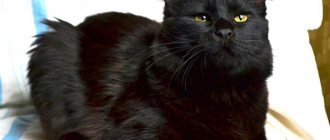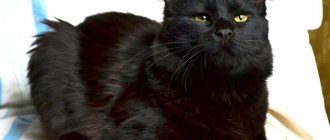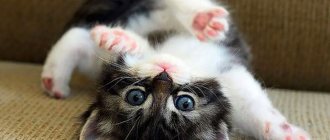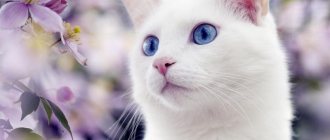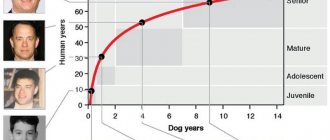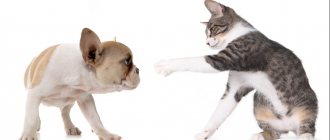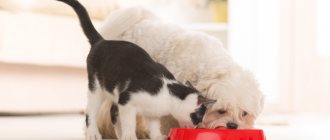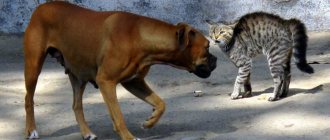Basic definitions
First, you need to understand the terminology - all purebred animals when sold have a document - a puppy passport (metric, card). It contains all the information about the baby:
- date of his birth;
- breed and color;
- nickname;
- information about parents and breeder.
If you make a choice in favor of a purebred baby, make a purchase through a specialized nursery. Puppies of Yorkshire terriers, Pekingese, Chihuahuas and others have a high cost. If there are offers on the market with low prices, most often it is a scam or they will sell you a mestizo.
Upon reaching the age of 6 months, the puppy passport is exchanged for a pedigree. This can be done by the owner himself or by the breeder if he sells the puppy at an older age.
Important: pedigree cannot be registered earlier than 6 months. If you are offered to buy a 3-month-old puppy with a ready-made pedigree, this is a scam.
But what should you do if a dog enters a house without a passport or pedigree? How to find out the breed of your dog?
Terms:
- Pedigree - a dog that has value in the breed, confirmed by a document. They are usually branded and microchipped;
- Metis is a dog whose breed cannot be documented, since it is the descendant of two different breeds, a purebred animal and a mongrel;
- Phenotype. If you hear the expression “by phenotype, an individual can be classified as a member of the husky breed,” this means that in its external characteristics the dog is similar to a husky, but there is no documentary evidence of this;
- Cur. Animals that do not have breed characteristics.
Photo: picryl.com
If the dog turns out to be mongrel...
If all attempts to determine the purebred of an animal are unsuccessful, it means that a lot of genes are mixed in the dog, and it is not purebred. This situation is especially unfortunate if the pet was purchased as a puppy with the hope that it would have specific characteristics.
People should remember that dogs of the Friend breed are no different from their purebred counterparts. They are just as devoted, faithful, they can give just as much love to their owner. They are no worse than purebreds.
Don't give up on a mongrel just because she doesn't belong to the elite class. Accept her and she will respond with boundless love. After all, the main thing is not the purity of the blood, but the spiritual qualities that your four-legged friend will give you.
Additionally, watch the video about determining the breed of a dog:
Video instruction
If you have not yet been able to recognize the breed of a certain dog shown in the photo, watch this video.
A dog is man's best friend. Almost everyone says this, and especially those who have such a pet. Some people have dreamed of having such a faithful, tailed friend since childhood, but for some reason they cannot get a dog. It also happens that one fine day a person decides that a furry pet should live in his family, but choosing a breed can sometimes take a very long time. Now let’s imagine a situation - you looked at photographs of different dogs on the Internet, and you really liked one breed, but how do you find out its name? For this purpose, there are services that allow you to find out the breed of a dog from a photo online.
We determine the breed by appearance
Identification of pedigree by appearance is one of the most accessible methods for independent determination. First, you need to determine roughly what breed group your pet belongs to and find the standards. There are international descriptions that are supplemented by national canine associations.
Age
If we talk about adult individuals, then it is possible to determine the breed only at the age of over one year, and for some groups this threshold is two years, so it is worth starting with determining the age.
The most common way to determine age is to examine the teeth. There is not too much reliability with this option: any animal, as a result of living on the street, can have the teeth of a very elderly animal. In any case, fully formed, non-baby teeth will help determine who is in front of us - a puppy or an adult dog, which is very important for miniature breeds: Spitz, hairless crested, lapdogs.
Size
Next, you need to examine the animal’s body, measuring its basic parameters, thereby making it possible to classify the dog into a specific group of breeds:
- dwarf - an adult dog typically weighs up to 5 kg, height at the withers - no more than 30 cm;
- small – from 5 to 1 kg, height from 30 to 40 cm;
- medium breeds - weigh no more than 22 kg, height parameters from 40 to 55 cm;
- large – from 25 to 30 kg, height from 55 to 67 cm;
- very large - from 40 to 55 kg, height at withers from 70 to 75 cm;
- giant - the rest, whose representatives exceed the above indicators.
The size of an animal within a breed group depends on gender: according to the standard, boys are usually noticeably larger than girls.
Skeletal structure (skeleton)
Studying the structural features of the dog’s skeleton, coupled with other external signs: the structure of the skull, the position of the ears and the structure of the auricles, the height and structure of the paws, will help to classify the dog into a more specific breed group. We can highlight:
- narrow-boned - narrow pelvis and narrow chest. The dogs are light and thin. with a sunken belly, thin slender but muscular legs. Adapted to fast running, they have a streamlined body shape and a dry constitution. Prominent representatives: Otterhound, Greyhound, Russian Greyhound, English Hound, Basenji, Jack Russell and Toy Terriers;
- medium - the chest is wider than the pelvis. This includes a wide range of breeds, mainly service breeds;
- broad-boned - the pelvis and sternum are equally wide and massive. These are physically developed animals with wide, high paws, a large skull and steel jaws. Typical representatives: retriever, alabai, Saint Bernard, mastiff, bandog;
- shortened body, shaped like a square. The hind limbs are usually somewhat shorter than the forelimbs. Representatives of the group are characterized by a shortened muzzle and nose. Most often, such a skeleton is found in miniature and dwarf breeds: Spitz, Pekingese, Maltese.
Additional signs will help determine the breed of the dog.
Additional signs
Let us highlight the important breed characteristics that can be found in international breed standards:
- posture - standards establish different inclinations of the spine: straight, with an inclination. Example: For Shepherd dogs, the standard incline is 20 degrees. If the angle changes, this is a reason for culling or treatment;
- structure of the skull. The dog’s head is examined in great detail, all the details matter: the severity of the transition from the forehead to the nose, the shape of the head and size;
- ears – location on the head and shape: high, hanging, erect or cropped;
- teeth and bite: standards for the shape of the bite, shape and color of teeth are established for each breed;
- eyes - color of the iris and white, shape and fit relative to the nose, depth. For example, bull terriers are considered to have a unique eye shape - triangular. The color of the fur around the eyes matters: for colored lapdogs there is a requirement - the contour of the eye should be outlined in black;
- neck. The maximum angle of inclination of the neck to the spine is important;
- tail – various standards for each breed: docking requirement, positioning relative to the back;
- limbs. There are different standards for the front and hind paws. Most of the requirements of the standard have a mathematical expression and require scrupulous measurements and calculations;
- coat is the most important feature. Not only the admissibility of colored colors matters, but also the condition of the coat itself: hard, straight, curly, etc. Often at exhibitions, a dog’s phenotype is determined by an expert by touch;
- color Note that the main colors are: black, white, brown and red. The remaining shades only indicate lightening of the primary colors and are complementary.
Understanding the terminology
Truly purebred individuals have special documents. Puppies must be sold with puppy passports containing information about the breed, name, date of birth, and color of the baby.
Attention! Fraudsters make money by selling dog and cat babies, passing off outbred puppies as purebreds.
Purebred Yorkshire terriers, Pomeranians, Papillons or Brabançons have a high price. Animals are the first to suffer when customers are deceived. If a promising puppy grows into a mongrel, he may simply throw the pet away.
Between the ages of six and fifteen months, this passport is exchanged for a pedigree. This document contains all the information about the pet, its ancestors and owner.
And if there are no documents, then how can you find out the breed of the dog? First you need to learn special terms: Metis is a mixed breed dog. Two or more breeds can be mixed in their genes. Puppies born from a purebred mother and mongrel father are also classified as mixed breeds.
A purebred (breeding, purebred) dog has a pedigree value reflected in documents - a pedigree. Often purebred individuals have special chips and a brand.
Phenotype - the expression “by phenotype the dog can be classified as a German Shepherd” means that outwardly all the signs of a German Shepherd are embodied in the animal, but the dog does not have documents confirming that the animal’s ancestors were indeed German Shepherds.
Important! A dog without documents is considered mongrel.
Another site for identifying the type of dogs and cats from photos
Sometimes all you can find out about a dog you like is a photo of it from the Internet. I would like to have exactly this one, and not something similar. But you need to remember that there are mixtures of dog breeds and species without a breed at all. Despite the fact that she has a great look and looks great. You can download a photo of the dog you like to your computer. Any browser can execute this command when you right-click on an image.
Find the dog search form on the Kisapes website
If you already have an image of an animal, the site Kisapes.ru/opredelit-porodu-po-foto/ will help you in your search:
- Follow the link and go down a little lower to the search form;
- Select how to provide the file: a link from the Internet or a photo;
- If you have a photo on your computer, click on the “Browse” button;
- We select a photo on the computer and wait until it is uploaded to the site server;
- Determining the breed here will take some time. After a few seconds, the dog breed and other information about it will appear on the screen.
Want to know what breed of dog you are like? Then provide your selfie to the site and wait for a response. Visitors leave requests for help in identifying the breed in the comments to the form.
Comments on the Kisapes website
In order to leave yours, you will need a VKontakte account. And also upload the photo you used in your comment. And after a while, other users will help you recognize the breed of a cat or dog from the image.
This is interesting: how to find a person by photo on VK.
other methods
By photo
The Internet offers specialized online services that determine the breed of a dog based on a photograph of the pet:
- https://www.bing.com/visualsearch/Microsoft/WhatDog;
- https://poroda-sobaki.by-photo.net/;
- https://www.proandroid.net/software-3659-magic-dog.html.
According to the test
The service allows you to determine the breed of a dog by verbal description. This is necessary, for example, if there is no photograph of the animal. In fact, the service helps to draw a conclusion based on the data collected by the owner and measurements of the pet:
- https://whoyougle.ru/services/dogs.
DNA
A new service offered by veterinary clinics is DNA testing to determine the breed. Let us note the disadvantages of this method:
- high price;
- a small database of samples for comparison, since the service is new;
- the result is not always reliable due to the presence of “impurities” in the selection.
Brand
It is easier to get information about a dog if there is a readable brand. To do this, contact a cynological organization, which one is determined from the RKF stamp database:
- https://www.dogsfiles.com/index.php?ind=tatoo;
- https://rkf.com.ru/razvedenie/.
Expert help
A veterinarian or dog handler can provide primary assistance in determining the breed. To confirm your guesses, you can contact a breed expert - in a club or nursery, talk with a breeder, or discuss the situation on an online forum.
Search for dog breed by image on the resource poroda-sobaki.by-photo.net
There are a large number of dog breeds in the world, reaching half a thousand. And almost all of them are different, with their own character, behavior, and color. Based on these parameters, although it is difficult, they can be distinguished. Therefore, we have a great chance of identifying the breed in the photo. The first resource will come to our aid with this - https://poroda-sobaki.by-photo.net/. It specializes only in finding dogs and its database contains all breeds, as well as their detailed descriptions.
All you need to search is a photo of your dog, which you can upload to the site:
- Follow the provided link and click on the “Select photo” button;
Click on the “Select photo” button - Explorer will open, where you need to find the folder with the dog’s photo on your computer;
Select a photo with a dog in Explorer - Then the screen will open on the right side - the image that you provided to the site, on the left - information about the breed.
Information about the dog with a description of the breed
Other images of the same breed that is in the user's photo will appear on the screen. Below it is a description: breed, color, life expectancy, weight for different sexes, similar breeds. From this information you can determine whether you need such a dog at home. Take a closer look at other similar breeds that are offered in the description. You can share the information found on social networks using the links below.
Let's take character into account
When determining the breed, it is very important to find out what kind of character the four-legged animal has. Each breed was bred for specific purposes. Hunting or sporting dogs are usually energetic and tireless, while service dogs are very hardy. Some breeds have a pronounced phlegmatic character (St. Bernard, Newfoundland), others behave with great dignity (Great Dane, Mastino Neapolitan).
Of course, there are exceptions. For example, a Labrador, if he works as a guide dog, will most likely be very calm, although in fact the breed is very energetic and playful. And an untrained bloodhound certainly will not give the impression of a serious hunting dog.
How to determine the breed from a puppy
Determining whether a puppy is purebred is a difficult task even for an experienced expert. Many purebred dogs under the age of 6 months are completely different from the adult dogs that will grow up from them: bobtail, Tibetan terrier, saluki, bearded collie, otterhound. And for more famous and familiar dogs, determining whether a puppy is purebred by appearance is often a failed task. The breeder's reputation in cynological circles is a guarantee of purchasing a purebred baby.
If the future pet does not have documents confirming its breed, perform all the same actions as for an adult, guided by the standards, but for puppies. It is not recommended to do this on your own; it is better to seek the help of an expert. In addition, specific signs can help: the Shar Pei has folds, the Bull Terrier has triangle eyes and a skull shape “like a pig”, and the Hairless Mexican has no hair.
Photo: defense.gov
By brand
If an animal has a mark or an electronic chip, then it will be easy to find out its pedigree. The brand is usually placed on the inside of the dog’s ear or groin, and the chip is placed near the withers. By contacting a veterinary clinic or dog handler, a specialist will accurately name the breed by identifier.
Assistance dogs
Many owners want to know what breed of puppy they were given. It happens that the animal is on the street, from where it ends up with a family. Someone wants to buy a purebred dog from their own hands without documents, saving on registration. Before getting a pet, you should learn as much as possible about its breed: about its external features, character inherent at the genetic level, and compare your physical capabilities necessary for training, walking and raising a particular animal.
Search directory
Once a complete description has been compiled, you can move on to finding a good reference book. Printed sources usually provide the most complete description of any dog breed. The list of varieties is quite large. You can search for similar directories on special services. All characteristics should be clearly visible in the photographs posted there.
Once you have found a photo of an animal that is somewhat similar to your pet, study it more carefully, especially the description of the standard of this species. As we have already mentioned, being not purebred greatly complicates the search, because mestizos can contain many different breeds mixed together.
If you managed to determine the standard, then you should double-check the result using other information sources.
I would like to note that the standard is a set of the most common characteristics. It is necessary to understand that slight deviations from the rules are always possible. That is why there are often dogs on the streets that do not correspond to the stated description, and therefore they are considered mongrels. To find a pet relative, you need to be patient.
Using a search engine to find out a dog's breed
The Google and Yandex search engines are equipped with image search tools. They know how to find all the information from their database that is available for a given image. Or similar to the picture you provided. To determine the exact breed of a dog, you need to open the “Pictures” search section and select the magnifying glass icon.
Searching for dog breeds using a search engine
When you provide an image or a link to it on the Internet, the search engine will give you all the pages for the request. From the description on them, you can determine what species the animal depicted in your photograph belongs to.
General recommendations
Here are some general recommendations for resolving this issue:
- Carrying out a DNA test. If you have already lost hope and don’t know what to do, then you can take a DNA test. Today the cost of such a test is quite small. The disadvantage is that there are not many animal species in the database yet, but there are the most popular ones. In any case, such a test will help make your task easier.
- Another tip is psychological testing. Check the natural instincts of the animal, this will make it possible to determine at least the group. That is, you can try to determine the herding qualities of a pet. As a rule, tame dogs are not at all interested in this.
- Consultations with specialists. Dog handlers and veterinarians always know more about animals than other people. Even if the veterinarian has not encountered a particular variety, he has a better chance of identifying it.
Methods for determining breed: general points
Experts identify several of the most accurate methods for determining the pedigree of an animal:
- electronic chip or mark. The mark-stamp is located on the inside of the ear or in the groin of the animal; the chip is most often installed in the area of the withers. If the animal has one of the above-described identifiers, you should contact a veterinary clinic or dog handlers organization, where they will check the information;
- DNA. This is the most reliable method for determining the breed of an animal, which will show the genetic combinations of different breeds. However, the procedure is not cheap, is not available everywhere, and is not developed for all breeds. Biological material for analysis is taken at a veterinary clinic;
- expert consultation. You can contact a veterinarian or a canine specialist, who, after examining the animal, will be able to tell what breed it belongs to;
- determining the breed by age using teeth. Determining the breed of a dog by age using the condition of its teeth is possible only if the animal has the correct bite and has been fed correctly.
Answer
If a person purchases a puppy from a nursery or from reputable breeders and has the necessary documents in hand, questions about determining the breed arise extremely rarely. If a dog came into the house by chance - you picked up a lost dog, bought a dog you liked at the market, or purchased it through a bulletin board on the Internet - you want to find out what type the pet belongs to.
The main points of determining the breed are discussed below. Take into account a number of necessary signs.
Cat classification
Cats are not distinguished by a variety of external forms, which cannot be said about dogs. Even despite their abundance and distribution throughout the planet, all cats are, in principle, very similar.
Active breeding work by felinologists began only at the beginning of the last century. And even at the present moment, when a clear gradation according to breed has appeared, it is difficult to judge how many purebred cats there are in the world. It is worth recognizing that the majority of domestic cats are still ordinary “nobles,” that is, completely outbred.
To date, the cat world has about 60 breeds, which also include two hundred varieties. According to the current classification, cats are conventionally divided into 5 large groups, which differ from each other in the length of their fur and features of their body structure:
- longhaired: Burmese, Persian, Turkish, Norwegian Forest, Maine Coon, Somali, Balinese, Siberian, Cymric;
- shorthaired with a strong constitution: European, American, Burmese, exotic;
- shorthaired with medium constitution: blue, Abyssinian, Burmese, Bombay, Korat;
- short-haired with a slender body: Siamese, Oriental, Singaporean, Tonkinese;
- cats with deviations in skeletal structure and mutations: male, Scottish fold, bobtail, multi-fingered, sphinx, rex.
Features of wool as a criterion
The coat of rumbling predators consists of guard hairs - long with a pointed tip, they can have different thicknesses and lengths, and downy hairs. Downy hair, in turn, is thin, short and often wavy, which acts as an undercoat.
A purebred cat can also be identified by the characteristics of its coat. Some breeds have long hair, some breeds have short hair, and some even have curls or no hair at all.
Long wool
Siberian cat
Long hair in cats is a process of mutation. By default, nature awarded cats with short fur for ease of hunting and survival.
The felinological organization has established more than thirty breeds of long-haired cats.
Bearers of luxurious long fur are the following breeds:
- British Longhair cat;
- American Curl, a distinctive feature is also the inverted ears, the tips of which point back;
- Chantilly;
- Long-haired Burmilla, which also has a snow-white coat and blue eyes;
- Himalayan cat, with a flat face;
- York chocolate cat;
- Somali;
- American and Kurilian bobtails with short tails;
- Maine Coons, with their characteristic ear tufts;
- Persians;
- Neva Masquerade;
- Norwegian Forest Cat;
- Burmese;
- Siberian;
- Turkish Angora and Turkish Van.
Somali cat
Norwegian Forest Cat
In the 15th and 16th centuries, long hair was considered a sign of nobility, and such cats came under royal patronage.
Short hair
British shorthair cat
Cats have had short hair for over 50 million years. It is much easier to care for short hair, both for the animals themselves and for their owners, than for long hair.
The most famous representatives of the short fur coat are:
- British Shorthair cat;
- Oriental Shorthair;
- Russian Blue;
- Safari;
- Siamese;
- Scottish cat;
- American Shorthair;
- Bengal;
- Burmese cat;
- Egyptian Mau
- Thai, who also has bright blue eyes;
- Singaporean,
- Ceylon cat;
- Exotic, similar to a plush toy with a flat nose;
- Abyssinian, with large ears and other breeds.
Ceylon cat
American Shorthair
Most of all cat breeds have short hair. The shorthair gene is active and stable.
In curls and without hair
Another distinctive feature of the breed is the curly coat or lack thereof. Both of these traits are the result of mutation.
The curly coat of a cat is a mutation and indicates the presence of the rex gene, which causes the coat to curl. All representatives with curly or wavy hair are classified as the "Rex" type. It is believed that the first representative of this mutation was noticed in the middle of the last century. And then breeders began to crossbreed mutation cats and male cats and produce new breeds with curly fur.
Cornish Rex
These representatives include the following cat breeds:
- The Cornish Rex is the first representative of this breed to have thin, long legs;
- Devon Rex, German Rex - have short curly fur and long thin legs;
- The Selkirk Rex is a long-haired, wavy wonder;
- Laperm also has a long curly coat;
- Skookum, which has not only curly fur, but also short legs;
- The Ural rex, first seen in Russia in the vicinity of the Sverdlovsk region.
Ural rex
Selkirk rex
No less curious representatives of a number of breeds are cats that are hairless. Although not all of them are actually completely bald. The history of hairless cats begins before our era and the basis of this characteristic is mutation. However, registration of hairless cats began in the late 20th century.
Kohana
Their representatives include such breeds as:
- Peterbald, which is the result of crossing the Don Sphynx and an Oriental cat. The birthplace of such a cat is St. Petersburg;
- Kohana means "bald" in Hawaiian. The skin of these representatives is wrinkled and there is no hint of hair at all;
- Minskin, in addition to the lack of a fur coat, has short legs. Feels like velvet;
- Bambino also has short legs;
- The Don Sphynx, which appeared in Rostov-on-Don back in 1980 as a result of the accidental birth of a hairless kitten;
- Dwelf, which has, among other things, ears turned back and short legs;
- Ukrainian Levkoy, which appeared as a result of crossing the Don Sphynx and the Scottish Fold cat. As a result, the cat has a bald body and ears bent forward;
- Canadian Sphynx with an abundance of folds and wrinkles;
- Elf, who received this name due to his ears bent back.
elf cats
Peterbald
Hairless cats require special care, as they get colder, dirt gets stuck in their folds, and they sweat. Therefore, they must be provided with timely hygiene and warmth.
Briefly about the main thing
- You can determine the breed yourself;
- There are several ways to determine: by external signs, using online services, DNA analysis, brands;
- The most accurate way is to read the mark;
- Without a pedigree, a dog is considered mongrel, although it belongs to a certain breed by phenotype.
Have you ever had to independently determine the breed characteristics of a pet? Which method did you use? Tell us about your experience in the comments.
Sources:
https://tvoidrug.com/breed/svojstva/opredelit-porodu.html https://prohvost.club/sobaki/porody-sobak/kak-opredelit-porodu-sobaki.html https://petguru.ru/interesnoe/ kak-uznat-porodu-dog
Features of pedigree kittens
Determining the breed of a kitten by phenotype is not always within the power of a professional. Some have such obvious natural features that they cannot be confused with anyone else; in this case, the table at the beginning of the article will help. Others differ so little from each other that they require the help of an experienced felinologist, supported by a genetic test.
Selkirk Rex
Balinese
Signs of thoroughbredness and obtaining a pedigree are important for those cases when the pet is awaiting breeding work or an exhibition career.
It must be remembered that the upbringing, love and appreciation of a cat is not determined by the “purity” of its blood.
1111
Features of body structure
In addition, there are a lot of features that will help classify a dog as a specific breed:
- Type of ears - they can be very small or disproportionately large, stand up or hang, be cropped or be of medium size.
- Tail type – long, short, straight or curled, raised above the level of the spine or lowered; covered with thick long or short hair, docked or not.
- Type of posture – in dogs there is a straight back and a downward one.
- The type of skin is tight-fitting, dense, or has excess in the form of folds.
- Coat type – sometimes the breed can be identified by the presence of a beard, hair over the eyes, or a certain covering of the paws.
- Type of color – presence of tan marks, spots, strict distribution of colors, brindle color.
In addition to everything, representatives of different breeds have their own “working” qualities. An outdoor hunting dog will sniff the air and take a stance when it sees its intended prey. Deep instincts are observed in herding dogs. Having met a domestic animal - a cow or sheep, the dog can begin to fulfill its duties.
If the pet does not show interest in hunting, herding livestock and does not bring a stick, then, most likely, it is also intended for an important task - to be a devoted friend and companion.
In any case, no matter what breed the pet belongs to, it will be a reliable protector, an excellent hunter, a best friend, and a faithful comrade if the owner loves and takes care of it.
Categories: Interesting things about dogs |
by Male
The main differences between purebred pets and domestic ones
Yard cat
There are about six hundred million cats on planet earth. This also includes wild, domestic and purebred animals. Pedigree cats make up about 10% of the total number. But they have their own characteristics.
The main determinant of the breed is the relevant documents for the animal:
- Veterinary passport of the animal indicating the vaccinations received;
- Metrics (birth certificate) indicating the breed, date of birth, name, breeder;
- Pedigree, indicating the parent (for breeding);
- Purchase and sale agreement (optional).
Pedigree for a purebred cat
Veterinary passport
Metrics
And without the appropriate documentation, the difference between a purebred cat and a barn cat can only be a misconception, since sometimes a cat with a pedigree is less similar to a representative of its breed than one who runs around the yard without a homeland and a flag.
But to properly care for the animal, you can try to determine the breed by external features, such as ears, skull shape, color and shape of the eyes, since each representative has its own special feature.
Outbred cats have small distinctive features and, as a rule, only in color, and their appearance is similar.
The main features of outbred cats:
- The physique is correct and proportional, medium size - up to 46 cm without tail;
- The ears are set straight up in a triangular shape of medium size;
- The head is round, the muzzle is slightly extended forward;
- Paws are long, of medium thickness;
- The eyes are round in normal position;
- The tail is long and straight.
However, purebred cats have their own obvious characteristics.
Ear shape.
It is one of the most prominent and characteristic features for a number of breeds.
Fold-eared cat types, when the ears are slightly turned out and the tips of the ears are directed downwards, include such cat breeds as the Scottish Fold shorthair and longhair, the British Shorthair, and the Ukrainian Levkoy.
Scottish Shorthair Fold
Ukrainian Levkoy
The breeds that have inverted ears, where the tips point backwards, are the American Curl, Highlander, and Elf.
American Curl
Representatives of the Maine Coon breed have large ears with tassels at the tips, while Savannah, Kanaani and Daven Rocks have large and wide ears. Huge disproportionate ears are characteristic of Oriental cat breeds and Abyssinians.
Savannah
Abyssinian cat
Head shape
The skull is also a distinctive feature of purebred cats.
The round shape of the skull and flattened nose are the main characteristics of such breeds as Persian cats, exotic shorthairs, Scottish folds, and British shorthairs.
Exotic shorthair
An elongated muzzle is characteristic of the following breeds: shorthaired Oriental, Abyssinian, Egyptian Mau, Havana, Siamese, Japanese Bobtail, Thai, Sphynx.
Egyptian Mau
Oriental Havana cat
Eye shape and color
Round and large eyes give special cuteness to such breeds as Scottish, British, Devon Rocks, Singapura, Ukrainian Levkoy, Ragdoll and Persian and exotic cats.
Devon Rocks
Singapore
Blue eye color is a distinctive feature of such breeds as: Oriental longhaired and shorthaired, Siamese, Turkish Angora, Thai, Bilanese, Burmese, Javanese, Ojos Azules.
Angora
Burmese cat
Also, cats with white fur usually have blue eyes.
Mixed Breeds – Benefits and Pitfalls
Mestizos have a more moderate temperament, since “gene” character traits are not common in mixed races. Of course, a puppy can be very active, independent and wary of other individuals. However, it cannot be compared with purebred dogs. The manifestation of “working” traits is an accident among mestizos. Such pets show greater sociability, adapt more easily to their owner, and quickly adapt to a new way of life.
As a rule, mixed breeds are healthier because they have an impressive diversity of genes. This is achieved due to the fact that the puppy’s parents do not have the same genes, so the risk of hereditary diseases is practically reduced to zero. But purebred dogs are prone to pathological characteristics, among which the leading ones are heart defects, obesity and diabetes.
Crossbreeds also differ in average size. Among mestizos, it is difficult to find an elongated body, like a dachshund, a barrel-shaped body, like a bulldog, or excessive weight, like a Diver. Average proportions help mestizos maintain excellent health and vigor.
Purebred dogs have an easily calculable predisposition to certain ailments. Which makes caring for them much easier. But among mestizos, it is almost impossible to calculate the “risk factor”. The worst option is to cross breeds that have common diseases. For example, a puppy whose parents were a poodle and a spaniel will be at risk for ear infections, eye diseases and hip problems.
Let's sum it up
Choosing a mixed breed will be an excellent option if you are prepared for the unpredictable nature of your pet, as well as for treating the animal if various diseases are detected. It is almost impossible to determine the future size of a puppy. Therefore, when buying a mixed breed for keeping in an apartment, there is a certain risk. A cute puppy can easily turn into a large individual.
When crossing different breeds, it is quite difficult to determine the dominant gene. So you can become the owner of a loving Rottweiler, a shy retriever or an overly large Chihuahua. It is impossible to know which gene will win the battle of the breeds. Often aggression dominates over friendliness, activity over calmness, cowardice over protective inclinations.
The advantages of mixed breeds include more developed intelligence, tactfulness and communication skills, and the ability to get along in almost any conditions. Mixed breeds are also more affordable.
General data on how long dogs live at home
Many owners, looking at their fluffy and mischievous puppies, wonder how long dogs live at home. Household members want their four-legged family member to delight with their presence for a long time, filling a person’s life every day with beauty, peace and joy.
Even the most competent specialist and expert dog handler will not be able to answer such a question with an exact number. The lifespan of a furry pet is an individual value and depends on many factors:
- breeds,
- genetic characteristics,
- quality of maintenance and feeding,
- environmental conditions.
However, there are average data according to which the life expectancy of dogs ranges from 10-13 years. Among the four-legged pets, there are also long-living record holders. Thus, there is information included in the Guinness Book of Records that a shepherd dog lived in Australia for more than 28 years.
Many dog handlers and dog lovers believe, not without reason, that the years a pet lives are directly dependent on its breed and size.
Little ones
Having chosen a small animal, owners want to know how long small dogs live at home. Long-term observations of representatives of miniature breeds give reason to believe that it is among them that one should look for long-livers.
Breeds such as dachshunds, terriers, lapdogs, small, toy and toy poodles can live a long life in a house with an owner by dog standards - 15-17 years. Experts attribute this phenomenon to the fact that small animals adapt more easily to external conditions, their genetic system is not overloaded and they are less susceptible to hereditary diseases.
Toy poodle
Large
Having chosen a puppy of a large breed, the owner must understand that the life expectancy of such an individual will not be significant by dog standards - 10-12 years. According to specialists, the aging of a massive pet begins after 6 years.
Representatives of such giant breeds as the Argentine Mastiff, Greater Swiss Mountain Dog, Neopolitan Mastiff, Bullmastiff, Newfoundland and others, unfortunately, do not have longevity. The average life expectancy of representatives of these breeds does not exceed 8-10 years.
Newfoundland and Argentine Mastiff
Zoological scientists believe that large dogs age and die earlier than their miniature relatives due to the fact that their bodies are highly susceptible to growth hormone. Increasing their weight almost 50 times from birth to puberty, large breeds are susceptible to the rapid accumulation of free radicals in the body, leading to aging of cells and tissues.
ъThus, complex selection work with large individuals left a negative imprint on the life expectancy of the giants of the dog tribe.
Sterilized
When thinking about performing an operation to remove the reproductive organs and gonads of dogs, the owner is also interested in the question of how long sterilized dogs live at home.
Over many years of practice in carrying out operations to sterilize or castrate animals, both domestic and foreign veterinary experts are unanimous in the opinion that such individuals live much longer than their sexually active counterparts. Experienced dog breeders and doctors attribute this dynamic to a number of factors.
First of all, in a sterilized female, the risk of premature death due to the pathology of pregnancy and childbirth is eliminated. In castrated males, there is a decrease in the incidence of genitourinary organs. The percentage of development of cancer pathology in the uterus and mammary glands in females who have undergone surgery decreases significantly.
In addition, sterilizing animals changes their behavior. The dog becomes more attached to the person and does not take part in aggressive “showdowns” and fights during sexual hunting. This significantly reduces the risk of the animal dying from injuries and bites. More obedient sterilized individuals are less likely to get into road accidents.
According to veterinary experts, the life expectancy of operated pets is on average 1-1.5 years longer than that of unsterilized pets. This scientific fact speaks in favor of using a surgical method to control sexual behavior in animals.
